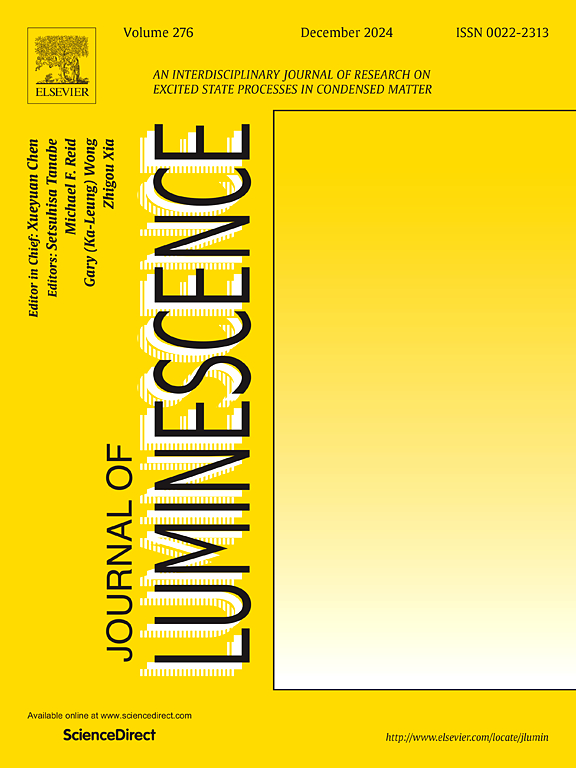Efficient CsPbBr3 sky-blue perovskite light-emitting diodes with enhanced stability via dual passivation using sodium sulfamate
IF 3.3
3区 物理与天体物理
Q2 OPTICS
引用次数: 0
Abstract
Perovskite light-emitting diodes (PeLEDs) have demonstrated considerable potential for application in next-generation display technologies, owing to their exceptional light-emitting properties and cost-effectiveness. However, the performance of perovskite-based blue PeLEDs remains inferior to that of green and red light-emitting devices. A primary factor contributing to this disparity is the substantial non-radiative losses, which result in a reduced photoluminescence quantum yield (PLQY) in the films. Here, we employ an additive strategy by incorporating sodium sulfamate (SAS) into the perovskite layer to passivate film defects and enhance the performance of blue PeLEDs. The results reveal that coordination between sulfamate ions and unsaturated Pb2+ ions significantly mitigates non-radiative recombination losses in the bulk-phase perovskites. Moreover, the amino group forms hydrogen bonds with adjacent halogen ions, thereby inhibiting their migration and further improving the passivation effect. Consequently, the SAS-modified blue PeLED devices achieved an external quantum efficiency of 5.47 % and an operational lifetime of 19.8 min, approximately double that of the control. Our findings provide valuable insights and effective strategies for realizing high-performance blue PeLEDs.
高效的CsPbBr3天蓝钙钛矿发光二极管,通过磺胺酸钠双钝化增强了稳定性
钙钛矿发光二极管(PeLEDs)由于其优异的发光性能和成本效益,在下一代显示技术中显示出相当大的应用潜力。然而,基于钙钛矿的蓝色发光二极管的性能仍然不如绿色和红色发光器件。造成这种差异的主要因素是大量的非辐射损耗,这导致薄膜中的光致发光量子产率(PLQY)降低。在这里,我们采用添加剂策略,将磺胺酸钠(SAS)加入到钙钛矿层中,以钝化薄膜缺陷并提高蓝色ped的性能。结果表明,磺胺酸盐离子和不饱和Pb2+离子之间的配位显著减轻了体相钙钛矿的非辐射复合损失。此外,氨基与邻近的卤素离子形成氢键,从而抑制了卤素离子的迁移,进一步提高了钝化效果。因此,sas修饰的蓝色PeLED器件实现了5.47%的外部量子效率和19.8分钟的工作寿命,大约是控制的两倍。我们的研究结果为实现高性能蓝色ped提供了有价值的见解和有效的策略。
本文章由计算机程序翻译,如有差异,请以英文原文为准。
求助全文
约1分钟内获得全文
求助全文
来源期刊

Journal of Luminescence
物理-光学
CiteScore
6.70
自引率
13.90%
发文量
850
审稿时长
3.8 months
期刊介绍:
The purpose of the Journal of Luminescence is to provide a means of communication between scientists in different disciplines who share a common interest in the electronic excited states of molecular, ionic and covalent systems, whether crystalline, amorphous, or liquid.
We invite original papers and reviews on such subjects as: exciton and polariton dynamics, dynamics of localized excited states, energy and charge transport in ordered and disordered systems, radiative and non-radiative recombination, relaxation processes, vibronic interactions in electronic excited states, photochemistry in condensed systems, excited state resonance, double resonance, spin dynamics, selective excitation spectroscopy, hole burning, coherent processes in excited states, (e.g. coherent optical transients, photon echoes, transient gratings), multiphoton processes, optical bistability, photochromism, and new techniques for the study of excited states. This list is not intended to be exhaustive. Papers in the traditional areas of optical spectroscopy (absorption, MCD, luminescence, Raman scattering) are welcome. Papers on applications (phosphors, scintillators, electro- and cathodo-luminescence, radiography, bioimaging, solar energy, energy conversion, etc.) are also welcome if they present results of scientific, rather than only technological interest. However, papers containing purely theoretical results, not related to phenomena in the excited states, as well as papers using luminescence spectroscopy to perform routine analytical chemistry or biochemistry procedures, are outside the scope of the journal. Some exceptions will be possible at the discretion of the editors.
 求助内容:
求助内容: 应助结果提醒方式:
应助结果提醒方式:


